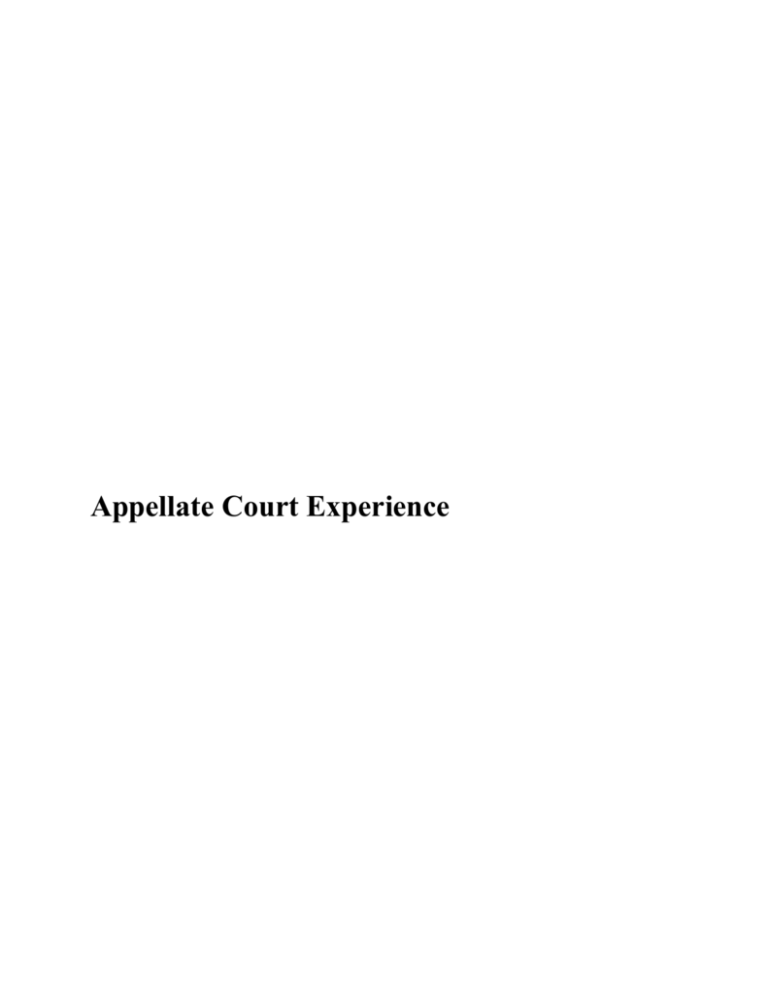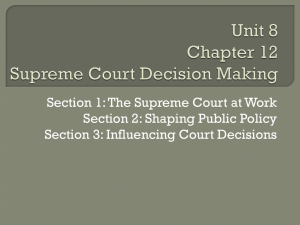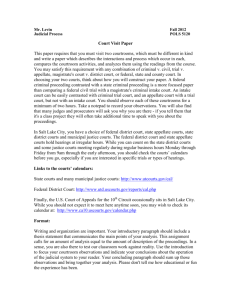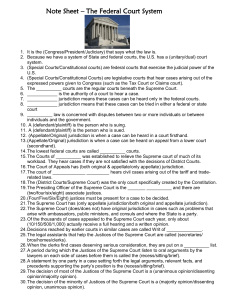Appellate Court Experience Guide
advertisement

Appellate Court Experience Appellate Court Experience A Program of Constitutional Rights Foundation In Collaboration with The Court of Appeal, Second Appellate District The Los Angeles County Bar Association’s Appellate Courts Committee (ACC), and The California Academy of Appellate Lawyers (CAAL). Developed by Marshall Croddy Written by Bill Hayes Graphic Design by Keri Doggett Production by Andrew Costly Constitutional Rights Foundation 601 South Kingsley Drive Los Angeles, CA 90005 (213) 487-5590 (213) 386-0459 Fax www.crf-usa.org Todd Clark Executive Director Marshall Croddy Director of Programs and Material Development 2005-2006 Contributors California Academy of Appellate Lawyers Edward Horowitz, Law Offices of Edward J. Horowitz Honey Kessler Amado Morris Polich & Purdy LLP Ventura County Community Foundation Appellate Court Experience Overview Appellate Court Experience provides students with an opportunity to deepen their understanding of the judicial system through a visitation to the California State Court of Appeal and two classroom sessions. At the visitation, students observe an oral argument of a criminal appeal and afterward meet with the justices. Teachers prepare students for the visitation through a PowerPoint presentation (or reading) on the court system, by discussing the case that students will observe, and by getting students to formulate appropriate questions for the visitation. Following the visitation, teachers hold a culminating classroom session in which students role play justices and decide the case they observed during the visitation. Teachers will then distribute the court’s opinion in the case and hold a discussion on the case and on what students have learned. Objectives and Goals Students will be able to: • Identify the organization and jurisdiction of federal and California courts and the interrelationships among them. • Explain the differences between appeal courts and trial courts, particularly that trial courts are responsible for findings of fact and appeal courts only deal with issues of law. • Identify basic parts of the appellate court process: the filing of briefs, oral arguments, justice conference, majority and minority decisions, and appeals to higher courts. • State the facts and issues of a particular case before the California Court of Appeal. • Discuss and form a reasoned opinion on this case. Standards Addressed California History-Social Science Standard 12.7: Students analyze and compare the powers and procedures of the national, state, tribal, and local governments. (7) Identify the organization and jurisdiction of federal, state, and local (e.g., California) courts and the interrelationships among them. California History-Social Science Standard 12.1: Students explain the fundamental principles and moral values of American democracy as expressed in the U.S. Constitution and other essential documents of American democracy. (5) Describe . . . the importance of an independent judiciary . . . [and the] rule of law . . . . Session 1: Preparing for the Visitation 1 Session 1: Preparing for the Visitation Overview In this session, students prepare for the visitation. The teacher gives students an overview of the program, presents a PowerPoint presentation on the court system, discusses the case they will observe, helps them brainstorm and choose appropriate questions for the visitation, and briefs them on proper decorum for the visitation. Preparation This lesson has a PowerPoint presentation. If you cannot do a PowerPoint presentation, a reading is provided. For the PowerPoint presentation: • CD—The Appellate Courts • Computer and projector for a PowerPoint presentation • Review Instructions for Using PowerPoint below. • Review the printout of the presentation and add notes that will help you give the presentation. If you cannot do a PowerPoint presentation, copies of Handout: Appellate Courts for every student. Consider assigning this handout as homework and then you can discuss it in class. This handout might even be helpful for students who receive the PowerPoint presentation. Preview of Case—You should receive a copy of this from the court. Make copies for every student. It will include a Case Synopsis (Procedural Background, Factual Background, and Issues), Vocabulary, and Summary Arguments. Handout: Courtroom Behavior—1 per student. Instructions for Using PowerPoint 1. Place the CD in the CD reader of your computer. 2. If PowerPoint isn't already running on your computer, start it. 3. In PowerPoint click on File and then Open from the menu bar. 4. Navigate to the drive assigned to the CD reader. The presentation will be listed in the Open dialog box (Appellate.ppt). 5. Select the presentation you want to open and double click or click on Open in the dialog box to open your selection. 6. Once the presentation is opened, click on Slide Show and then View Show on the menu bar to start the presentation. 2 Procedure A. Introduction 1. Ask students whether they have visited a courtroom or seen one portrayed on television or in the movies. Ask them to describe the courtroom. (Most will probably describe a trial court.) Tell students that another type of court is an appellate court, or court of appeal. Explain that these courts are far different from trial courts—the opposing attorneys present arguments to the justices. No witnesses or other evidence is presented. Appellate courts decide important issues of law. Cite the U.S. Supreme Court as an example of an appellate court. 2. Tell students about the program—i.e., that they will be learning about the court system, visiting a California State Court of Appeal, observing an oral argument before the court, and meeting the members of the court. B. PowerPoint Presentation (or Reading) and Discussion 1. Tell students that before they visit the court, they are going to learn more about appellate courts. 2. Give the PowerPoint presentation. See Instructions for Using PowerPoint, above under Preparation. A printout of the PowerPoint presentation is included. (A space is provide on the printout for your notes.) Consult this printout during the presentation. If you cannot give the PowerPoint presentation, then distribute Handout: Appellate Courts to students and have them read it. 3. Following the presentation (or reading), hold a brief review discussion by asking: a. What is the difference between an appellate court and a trial court? b. A case beginning in a Los Angeles Superior Court could reach the U.S. Supreme Court. What courts would it go through before it reached the U.S. Supreme Court? [(1) Superior Court, (2) California Court of Appeal, (3) California Supreme Court, and (4) the U.S. Supreme Court. (This court would only have jurisdiction if the case had a federal issue, such as a question of U.S. constitutional law.)] c. What is judicial independence? Why is it important? C. Preview of the Case 1. Tell students that you have information on the case that they will observe at the courthouse. Distribute Preview of the Case to students. 2. Carefully go over each section—the Case Synopsis (Procedural Background, Factual Background, and Issues), Vocabulary, and Summary Arguments. Discuss and answer 3 questions that students may have. D. Brainstorming Questions 1. Explain that after the oral arguments, students will meet with the justices and perhaps with appellate attorneys. Explain that court rules prohibit justices from discussing the cases before them and future cases, but that students can ask other questions. Ask students to brainstorm questions that they would like to ask. Write the questions on the board. If necessary, use these prompts to elicit questions: Education of judges Appointment of judges Number of judges and appellate courts The process of judging a case The appellate process Grounds for appeal Comparison of state and federal courts Comparison of appellate to trial courts Careers in law Qualities of a good judge Criminal law issues 2. After the brainstorm, ask students to select the best questions. Have students write these questions down so that they can refer to them when meeting the justices. E. Proper Behavior 1. Explain that certain behavior will be expected during the visitation. Distribute the handout Courtroom Behavior to students. Review it and answer any questions that students may have. 2. Review other relevant matters (e.g., rules of behavior for the bus, trip slips, date of the visitation). Remind students to bring their questions and the handout Courtroom Behavior to the visitation. 4 5 Handout Courtroom Behavior During the visitation to the California Court of Appeal, the following behavior is expected: • Before entering the courtroom, you must pass through a metal detector. To make this procedure as easy as possible, avoid wearing or carrying metal objects. The security is similar to that of an airport. Items that are not permitted in the courtroom will be confiscated. Do not bring any of the following items: • • • • • Any object that might be construed as a weapon, such as knives of any size (including Swiss army knives), metal nail files, knitting needles, hair appliances, medal combs, or scissors. Hair spray or any other aerosol containers. Any controlled substances. Flammable liquids. Recording devices (such as tape recorders, mp3 players, cameras/camera phones, etc.) • Be polite and courteous to the justices, to court personnel, and to those around you. • Cellular phones, pagers, and other electronic devices must be turned off. • Suitable attire is required. No hats, sunglasses, shorts, tank tops, or dirty, damaged, or illfitting clothing will be permitted in the courtroom. • No food, drink, or chewing gum is permitted in the courtroom. • When the court is in session, be silent. A court session begins when the justices enter and take their seats and a court official announces that the court is in session. A similar procedure is used when court adjourns. During the meeting with the justices after the court session: • Raise your hand and wait to be called on if you want to ask a question. When called on, stand up and speak loudly and clearly. Address a justice as “Your Honor” or “Justice” and the justice’s name, e.g., “Justice Smith.” • Do not ask questions about the case you observed or any other cases before the justices. Justices are not allowed to discuss the cases before them or any future cases. 1 Handout The Appellate Courts In writing the U.S. Constitution, the founders created an independent judicial branch. One way they insured judicial independence was by giving federal judges life terms in office. Alexander Hamilton noted in Federalist No. 78 that “nothing can contribute so much to [judicial] firmness and independence as permanency in office . . . . He called life terms an “indispensable ingredient” to the judiciary and said they helped protect “public justice and the public security.” Federal Courts In the federal court system, the president appoints the judges. The Senate must vote to confirm the appointment. Once appointed, the judges serve life terms. The federal court system has three levels. On the lowest level are the District Courts. There are 94 District Courts—at least one in each state. These are the trial courts in the federal system. After a trial, a case may be appealed to a U.S. Court of Appeals. There are 13 Circuit Courts of Appeals. The Ninth Circuit hears appeals from District Courts in California. After the court decides, the case may be appealed to the U.S. Supreme Court. Nine justices sit on this court, the highest court in the land. Its decisions are final. The chart below shows the appellate process for the federal courts: U.S. Supreme Court Circuit Courts of Appeals District Courts The federal courts handle all federal cases, such as . . . • Admiralty cases (involving ships at sea) • Bankruptcy cases • Federal tax cases • Copyright or patent cases • Cases in which one state sues another state • Federal criminal cases, such as crimes on federal property, crimes on aircraft, crimes on the high seas, federal drug cases, postal fraud, racketeering. Most cases, however, are handled in state courts. Each state has its own court system. California Courts California’s court system, like the federal system, has three levels. Most cases begin in the Superior Courts, the trial courts. 2 Each county has a Superior Court. When a trial ends, the case may be appealed to a California Court of Appeal. In the Court of Appeal, panels of three justices decide the cases. After the decision, the case may be appealed to the California Supreme Court—the highest California court. Seven justices sit on this court. They select which cases to hear. The decisions of the California Supreme Court are final unless they involve questions of federal law. If a case has a federal issue, it can be appealed to the U.S. Supreme Court. Below is chart showing the appellate process for California courts: California Supreme Court U.S. Supreme Court (for federal issues) Courts of Appeal Superior Courts Like other state courts, California courts handle cases such as . . . • • • • • Family law (divorce, child custody, child support) Torts (lawsuits on harm caused intentionally or by negligence) Contract disputes Landlord-tenant cases Probate cases (wills, trusts, and inheritances) These are all examples of civil law. California courts also handle criminal cases, such as . . . • • • • • • • • Murder Assault Rape Robbery Burglary Car Theft Theft Drug Offenses All judges in the California courts must have been admitted to practice law in California for 10 years before being appointed. The governor appoints all the appellate justices (those on the California Courts of Appeal or California Supreme Court). The California Commission on Judicial Appointments must approve the selections. (The commission has three members: the chief justice of the Supreme Court, the attorney general, and a senior presiding justice of the Court of Appeal.) California voters must confirm the justices at the next election. Justices serve 12-year terms. When a justice’s term ends, the justice must be confirmed again by voters for another 12-year term. 3 Trial Versus Appellate Courts It is important to understand the differences between trial courts appellate courts. Most cases begin in trial courts (in California, these are the Superior Courts). In a trial court, one judge presides. Lawyers present evidence. The evidence comes from witnesses, which lawyers examine and cross-examine. A jury hears the evidence and gives a verdict. (If the defendant waives a jury trial, a judge may hear the case without a jury.) After the trial, a criminal defendant may appeal the case. The appeal must claim that there was an error of law. For example, the defendant might claim that the judge made a mistake instructing the jury, or that a law is unconstitutional, or that the judge allowed evidence that should not have been let in. appeal courts do not hold trials. No evidence is introduced. A panel of justices hears the appeal. Lawyers on each side submit written arguments, called “briefs.” The lawyers use prior court cases and existing laws to argue their cases. At the appellate court hearing, the lawyers present oral arguments and the justices question them. After the oral arguments, the justices discuss the case among themselves. After deliberating on the case, they vote. One justice is chosen to write the opinion of the court. It tells the facts of the case, the issues, the decision, and the reasons for the decision. If a justice disagrees with the decision, he or she may write a dissenting opinion. The written opinions of the court become law for the lower courts to follow. Our Class Visitation Our class is going to visit a California Court of Appeal. We will observe an oral argument on a criminal case that has been appealed. The attorneys for the prosecution and defense have already submitted written briefs to the court. The justices have read the briefs. The briefs have explained the facts of the case, stated the issues on appeal, and presented the arguments for each side. At the hearing, the attorneys will deliver their best arguments to the court and be questioned by the justices. For Discussion 1. What is the difference between an appellate court and a trial court? 2. A case beginning in a Los Angeles Superior Court could reach the U.S. Supreme Court. What courts would it go through before it reached the U.S. Supreme Court? 3. What is judicial independence? Why is it important? 4 5 Session 2: Visitation Session 2: Visitation Overview For this session, students travel to the courthouse. In preparation for the visit, students briefly review their prepared questions and courthouse rules. At the courthouse, they observe the oral arguments for the criminal case that they have learned about and then meet with the justices and ask them the questions that they have prepared for the visitation. After they return, students are asked to make a summary of the oral argument. Preparation Students should bring: The questions they prepared in session one. The Courtroom Rules handout from session one. Handout Summary of Visit (optional)—1 per student to be passed out and completed after returning from the visitation. Procedure A. Before Embarking Remind students of the case that they will observe. Review the courtroom rules and make sure students have the questions that they are going to ask. Tell students to pay close attention to the oral argument. B. Oral Argument Students will listen to the oral argument of the case they learned about. C. Meeting With Justices Following the oral argument, students will meet with the justices and ask them questions. D. After the Visitation 1. Consider assigning students to write a summary of the oral arguments that they heard. Distribute handout Summary of Visit, which has a simple format for reporting on the case. Tell them to turn in the completed handout at the next class session. 2. Remind students that they will have one more session on the California Court of Appeal. In that session, they will find out how the court ruled on the case they heard. Handout Summary of Visit Today you observed an oral argument in a criminal case before the California Court of Appeal. Write a brief summary of what you observed by answering the following questions: 1. What were the facts of the case? 2. What issue or issues did the court have to decide? (You should answer this in the form of a question that the court was to answer.) 3. What arguments did the defense make? 4. What arguments did the prosecution make? 5. What did you learn from this visit to the California Court of Appeal? Session 3: Culmination Session 3: Culmination Overview After receiving the decision of the court on the case heard at the visitation, the teacher will conduct the final session. Students review what they have learned. Then they role play an appellate court and decide the case they observed. Next, they find out and discuss the actual court decision. Finally, they fill out an evaluation of the Appellate Court Experience Program. Preparation Handout Court Decision—1 per student. You will receive this after the court decides the case. Study the decision before distributing it. Handout Evaluation of Program—1 per student The completed Summary of Visit to be passed back to students. Procedure A. Review 1. Return to students their completed Summary of Visit. 2. Conduct a review of what they have learned by asking students: • What are the three levels of courts in the federal court system? [Write the answer on the board so that you have chart like this: U.S. Supreme Court U.S. Courts of Appeals District Courts (the trial courts)] • What are the three levels of courts in the California court system? [Write the answer next to the federal court system so that you have chart like this on the board: U.S. Supreme Court California Supreme Court U.S. Courts of Appeals California Courts of Appeal District Courts (the trial courts) Superior Courts (the trial courts)] • How can a case that begins in a California Superior Court end up in the U.S. Supreme Court? [Ask a student to trace the appellate process that goes from the Superior Court, to the California Court of Appeal, to the California Supreme Court, and finally to the U.S. Supreme Court (if there is a federal issue).] • What kinds of cases are heard in federal courts? (Admiralty, bankruptcy, federal taxes, copyright, states suing one another, and federal criminal cases, such as crimes on federal property, crimes on aircraft, crimes on the high seas, federal drug cases, postal fraud, racketeering.) • What kinds of cases are heard in California courts? (Almost all other types of cases, e.g., family law, torts, contracts, criminal.) • What are the differences between appeal courts and trial courts? (Among other differences, students should note that trial courts are responsible for findings of fact and appeal courts only deal with issues of law.) B. Role Play of Court Decision 1. Ask students to recall the case that they heard at the visitation. Hold a discussion of the facts, issues, and arguments. (Students can use their completed Summary of Visit to help them discuss the case.) 2. Tell students that they are going to role play the court making the decision in the case. Divide the class into groups of three. Assign each group member of the role of either prosecution attorney, defense attorney, or judge. 3. Ask all the defense attorneys to meet on one side of the room, all the prosecution attorneys to meet on the other side, and the judges to meet in the front. Ask the attorneys to develop arguments and the judges to develop questions to ask the attorneys. Meet with the group of judges and explain that they are going to conduct a hearing like the one at the California Court of Appeal. Tell them they should have the defense attorney present arguments first and then the prosecution attorney. Tell them that they can ask questions of either side at any time. 4. When students are ready, have them meet once again in their groups of three. Have the judge in each group run the hearing and listen to arguments from both sides. Set a time limit of about five minutes for the whole hearing. 5. When time expires, ask the judges to come to the front of the room and hold deliberations. Have them discuss the case and vote. When they vote, they should give the reasons for their decision. C. The Actual Court Decision 1. Tell students that the Court of Appeal has decided the case. Distribute the handout Court Decision to students. Ask them to read the handout. 2. After they have read the handout, hold a discussion by asking students: • What was the decision in the case? • Why did the court reach this decision? • What do you think might happen next in the case? (E.g., retrial, appeal to the California Supreme Court) D. Evaluation of Program Ask students to fill out an evaluation of the three sessions telling what they learned and what they felt was valuable.









